It looks like you're using an Ad Blocker.
Please white-list or disable AboveTopSecret.com in your ad-blocking tool.
Thank you.
Some features of ATS will be disabled while you continue to use an ad-blocker.
share:
...and back to some points here...
So... are you trying to say that some master builder race came in and built all the stone buildings in Egypt while the native population just sort of sat around in bewilderment?
And what about the inscriptions on the temples that indicate which pharaoh built which phases and evidence from nearby tombs of people who said they were in charge of construction and/or maintenance and/or service in the temple?
And what about the temple of Seti I (with which it's integrated) and changes in the temple itself (there's an area where the columns are crowned by lotus buds... and a different section with no lotus bud columns)? Are you proposing that an ancient unknown race also did this temple as well?
If you propose an "ancient unknown sophisticated race" then you also have to show that they're not Rainbow Unicorns. In other words, people don't just suddenly wake up one morning and say "the heck with the bushes and leaves. I'm going to invent hardened bronze tools today and start building big stone buildings." They have to first master fire and then ovens and then acquire basic metallurgy and toolmaking while having enough food and shelter and a large enough workforce to do buildings. This means they would leave traces of themselves, from the "wandering around the bushes and throwing things into rubbish heaps (middens)" stage to the "sophisticated builder" stage.
So what evidence do you have to support the "unknown builders" (cities, etc)?
Take another look at the walls of the Osireion. They are not irregular sizes. A few have unusual shapes but they are not irregular sizes. Nor are they granite.
Not sure about the knobs/bosses though it's possible that they were support structures to hold logs or planks for a roofing.
Can you list one or two examples with links so we can see just how similar the workmanship is?
In that case, they should have been using symbols derived from this "lost civilization" and using their systems of measurement. So why isn't there a common ground?
What evidence do you have that the Easter Island area was settled before 700 AD (which is about the time the Polynesians said they settled the area) ... and in fact was settled before 1200 BC?
The statues have foundations? There are photos of a group of them set up on a landscape, but they were moved there and those foundations are modern. Can you link to the foundations you're talking about?
The site says it'sprobably Incan and from the 1500's and that it's consistent with the Incan stonework of that time. Why don't you think that this is correct (Incan and 16th century)?
originally posted by: jeep3r
originally posted by: Byrd
So how do you respond to these points:
* there are thousands of Egyptian temples and tombs older than this that show the same types of stonework (many pyramids, for example, have that gabled roof you showed a photo of.) Why do you think they forgot how to make stone gables?
Thanks for chiming in, Byrd. The fact that there is a certain consistency in architectural style compared to other monuments (e.g. when looking at the gabled roofs) could mean that we're talking about the same builders, not necessarily AE even if pottery and graffiti found in that area would indicate exactly that.
So... are you trying to say that some master builder race came in and built all the stone buildings in Egypt while the native population just sort of sat around in bewilderment?
And what about the inscriptions on the temples that indicate which pharaoh built which phases and evidence from nearby tombs of people who said they were in charge of construction and/or maintenance and/or service in the temple?
And what about the temple of Seti I (with which it's integrated) and changes in the temple itself (there's an area where the columns are crowned by lotus buds... and a different section with no lotus bud columns)? Are you proposing that an ancient unknown race also did this temple as well?
If you propose an "ancient unknown sophisticated race" then you also have to show that they're not Rainbow Unicorns. In other words, people don't just suddenly wake up one morning and say "the heck with the bushes and leaves. I'm going to invent hardened bronze tools today and start building big stone buildings." They have to first master fire and then ovens and then acquire basic metallurgy and toolmaking while having enough food and shelter and a large enough workforce to do buildings. This means they would leave traces of themselves, from the "wandering around the bushes and throwing things into rubbish heaps (middens)" stage to the "sophisticated builder" stage.
So what evidence do you have to support the "unknown builders" (cities, etc)?
This is where it gets interesting: not all of the Peruvian stones are just cladding. Some of them are, in Cuzco for example, but by far not all of them. But even some of those decorative stones that don't have precision fitting at the back, are quite massive and the exact method of how to obtain such results is still under debate. Some of the Egyptian stones also feature irregular sizes and patterns (with precision fitting) plus knobs/bosses, partly in granite, which are extremely similar to the Peruvian style.
Take another look at the walls of the Osireion. They are not irregular sizes. A few have unusual shapes but they are not irregular sizes. Nor are they granite.
Not sure about the knobs/bosses though it's possible that they were support structures to hold logs or planks for a roofing.
On the other hand, we know from different cultures across the globe that similar styles can be found in these megalithic structures: in granite, limestone, sandstone, andesite, what have you... but yet showing similar workmanship. So perhaps we should keep an open mind here?
Can you list one or two examples with links so we can see just how similar the workmanship is?
This would imply that the builders were indeed either Inca or Ancient Egyptians, the picture would change a bit if we assume a lost civilization which left behind these monuments and not much else (at least nothing that has officially been found so far).
In that case, they should have been using symbols derived from this "lost civilization" and using their systems of measurement. So why isn't there a common ground?
* how could Easter Island have learned these techniques over a thousand years after the Osireion was constructed? Wouldn't they have come up with new techniques by then? And why do you think the relatively crude statues of Easter Island compare to the monumental statues of Egypt?
Again, this implies that the dating is correct. If you stick with the official version then you are right and I'm wrong, it's as simple as that.
What evidence do you have that the Easter Island area was settled before 700 AD (which is about the time the Polynesians said they settled the area) ... and in fact was settled before 1200 BC?
Apart from that, I'm not so much referring to the statues but rather to the foundations of the statues in some exposed areas, which show a striking resemblance in style when compared to Peruvian megalithic architecture associated with the Incas.
The statues have foundations? There are photos of a group of them set up on a landscape, but they were moved there and those foundations are modern. Can you link to the foundations you're talking about?
An example for this could be the megalithic platform at Vinapu on Easter Island, which I have referenced in an earlier thread here.
The site says it'sprobably Incan and from the 1500's and that it's consistent with the Incan stonework of that time. Why don't you think that this is correct (Incan and 16th century)?
a reply to: burgerbuddy
Another thing which got me thinking is this supposed Viking construction in Greenland, it might have also been a Megalith built by who knows, and then used as the base for the then more modern Vikings.
Another thing which got me thinking is this supposed Viking construction in Greenland, it might have also been a Megalith built by who knows, and then used as the base for the then more modern Vikings.
I sure missed this place , and all of you guys.......ive been on quite the journey.......looking forward to getting back in the middle of the herd
around here
the one most interesting question for me though is why the EA would build their mortuaries and bigger monuments with these HUGE sandstone slabs
in the first place...( Khafre mortuary temple, Osieiron etc..) It would have been much easier with smaller sandstones ( and clad in granite ).
Roofing sandstone slabs ok, but walls etc which required much sawing with quartz sand and copper blades..
Just the kings could?
Roofing sandstone slabs ok, but walls etc which required much sawing with quartz sand and copper blades..
Just the kings could?
edit on 20-12-2017 by anti72 because: (no reason given)
originally posted by: Byrd
...and back to some points here...
Can you list one or two examples with links so we can see just how similar the workmanship is?
Of course, here go some examples that IMO show intriguing similarities in the construction styles throughout different cultures around the world:
Megalithic blocks extending around corners:
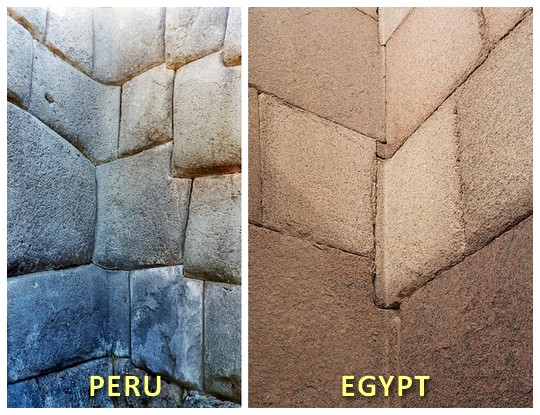
Bosses/knobs:
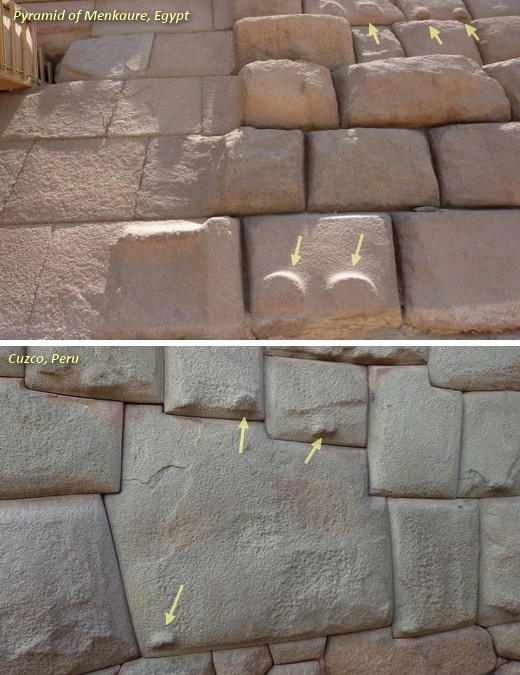
Peculiar small "fill-ins" in megalithic walls
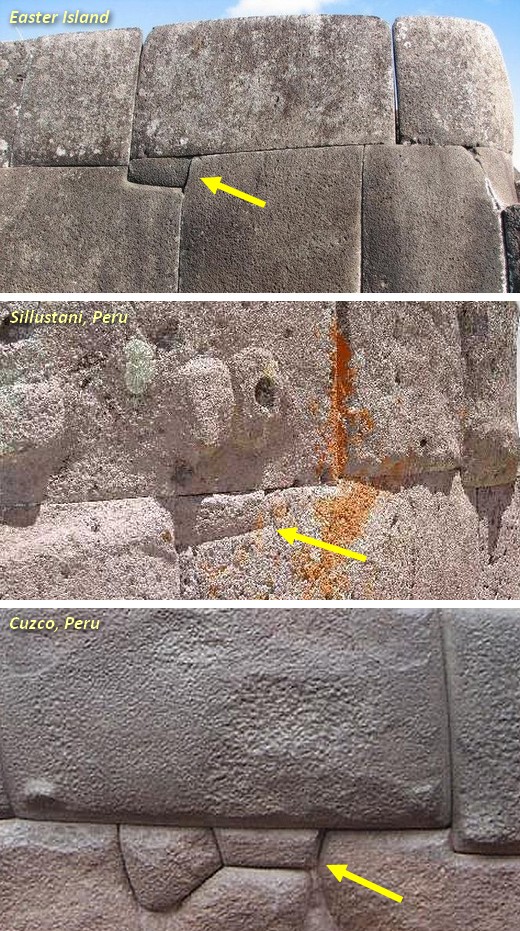
Polygonal walls, continents apart:

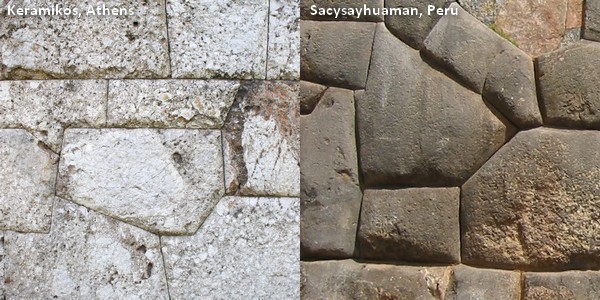
Metal clasps connecting megalithic blocks:
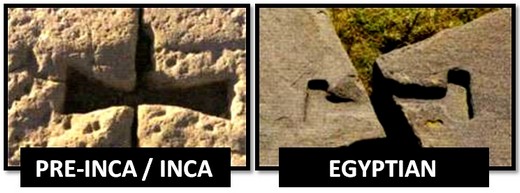
Precision fitting, beveled edges, filling stones, same surface texture
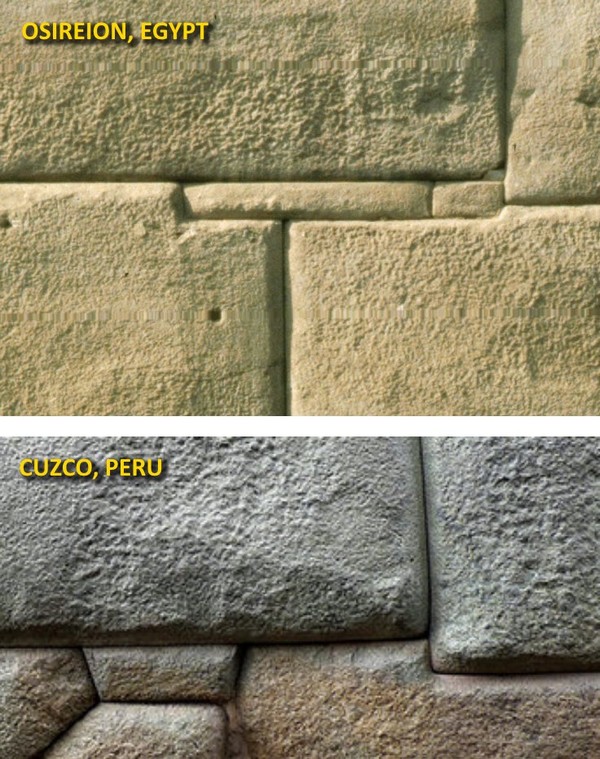
originally posted by: anti72
the one most interesting question for me though is why the EA would build their mortuaries and bigger monuments with these HUGE sandstone slabs in the first place...( Khafre mortuary temple, Osieiron etc..) It would have been much easier with smaller sandstones ( and clad in granite ).
Roofing sandstone slabs ok, but walls etc which required much sawing with quartz sand and copper blades..
Just the kings could?
Yes, only the kings could. Nobles, etc, had tombs that were generally carved into the rock. Middle class and peasants got holes in the ground (Middle class got nicer holes than the peasants.)
Making a temple like that was expensive and called for a lot of workers and a lot of stone. The wealthiest people in the land were the high priests, the viziers, and the royal family... but only the royal family could command the wealth of the entire country. While any wealthy family today could command enough resources to build a temple like that, back then it was a very different proposition. In addition, they often built up or renovated older structures... but it was still costly in terms of time and labor.
originally posted by: jeep3r
originally posted by: Byrd
...and back to some points here...
Can you list one or two examples with links so we can see just how similar the workmanship is?
Of course, here go some examples that IMO show intriguing similarities in the construction styles throughout different cultures around the world:
Megalithic blocks extending around corners:
(removed most of the photos to make for easier reading in the thread
I don't think you've made your case. In many cases you're showing two structures that were built more than a thousand years apart (or 2,000 years in at least one case.) And you aren't showing the full blocks but only one angle on them.
In addition you're looking at different types of materials and you aren't looking at the more important parts - how the faces of the blocks are shaped. If you look at how flat the exteriors are and how fitted they are, you will see that they're not very similar.
Finally, the idea of "ancient megalithic civilization" doesn't explain why they have this same technique at different time periods. Are we to assume that these Ancient Builders ("AB"s)show up and teach a technique to the Egyptians and then teach something different elsewhere and never actually improve their own technique (in other words, the AB's never get newer and better tools, never show others how to make improved tools, never learn to make talatat-sized blocks that one person can carry, never learn better methods of transport in the thousands of years that this idea says it took them to go from Egypt to Greece to South America? And in fact, when they get to South America they're actually using older techniques on rock although it's almost four thousand years later?
a reply to: Byrd
Is it possible that the dating of some of these structures is very wrong?
And what about the "Metal clasps connecting megalithic blocks"? Are you suggesting that cultures around the world which supposedly had no contact actually spontaneously came up with this technique independent of each other yet somehow replicated it in such a similar fashion?
Is it possible that the dating of some of these structures is very wrong?
And what about the "Metal clasps connecting megalithic blocks"? Are you suggesting that cultures around the world which supposedly had no contact actually spontaneously came up with this technique independent of each other yet somehow replicated it in such a similar fashion?
a reply to: muzzleflash
So the bronze age re the metal clasps popped up in two different cultures, along with the same type of building technique, most were scavenged and melted down, which seems to suggest, people without the tech to smelt just used what was there.IE a higher tech replaced by a lower one. Like we would mine cars for spring steel and hard shafts, which would remove all the cars from history, in a SHTF situation.
So the bronze age re the metal clasps popped up in two different cultures, along with the same type of building technique, most were scavenged and melted down, which seems to suggest, people without the tech to smelt just used what was there.IE a higher tech replaced by a lower one. Like we would mine cars for spring steel and hard shafts, which would remove all the cars from history, in a SHTF situation.
new topics
-
Outgoing Lame Duck BIDEN Officials and Democrats Voice Their Regrets.
2024 Elections: 2 hours ago -
Reflections of Elections past
US Political Madness: 4 hours ago -
President Carter has passed
Mainstream News: 6 hours ago -
Get Reday - Here comes the Bird Flu Pandemic - Millions are Notified
Diseases and Pandemics: 7 hours ago -
2 Guys die hunting Bigfoot
Cryptozoology: 7 hours ago -
Joe Rogan and The Black Keys Diorama
General Entertainment: 9 hours ago
top topics
-
Get Reday - Here comes the Bird Flu Pandemic - Millions are Notified
Diseases and Pandemics: 7 hours ago, 16 flags -
President Carter has passed
Mainstream News: 6 hours ago, 15 flags -
2 Guys die hunting Bigfoot
Cryptozoology: 7 hours ago, 6 flags -
Reflections of Elections past
US Political Madness: 4 hours ago, 5 flags -
Outgoing Lame Duck BIDEN Officials and Democrats Voice Their Regrets.
2024 Elections: 2 hours ago, 4 flags -
Joe Rogan and The Black Keys Diorama
General Entertainment: 9 hours ago, 3 flags
active topics
-
Get Reday - Here comes the Bird Flu Pandemic - Millions are Notified
Diseases and Pandemics • 19 • : DontTreadOnMe -
-@TH3WH17ERABB17- -Q- ---TIME TO SHOW THE WORLD--- -Part- --44--
Dissecting Disinformation • 3846 • : 777Vader -
Why Such An Uproar Over Non-US Citizens With H1-B Work Visas.
Social Issues and Civil Unrest • 79 • : cherokeetroy -
President Carter has passed
Mainstream News • 11 • : Lumenari -
Outgoing Lame Duck BIDEN Officials and Democrats Voice Their Regrets.
2024 Elections • 3 • : SteamyAmerican -
This is why ALL illegals who live in the US must go
Social Issues and Civil Unrest • 35 • : charlyv -
2 Guys die hunting Bigfoot
Cryptozoology • 15 • : Lumenari -
Danish Prime Minister said to keep 3 days worth of canned goods on hand
World War Three • 16 • : Irishhaf -
New UK Petition - Close the borders! Suspend ALL immigration for 5 years!
Regional Politics • 9 • : Astrocometus -
Reflections of Elections past
US Political Madness • 2 • : charlest2
